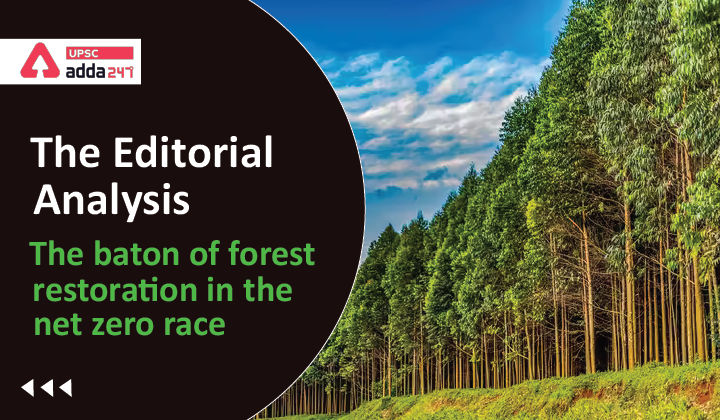Table of Contents
Forest restoration in India: Relevance
- GS 3: Conservation, environmental pollution and degradation, environmental impact assessment.
Forest management in India: Context
- In the recently concluded COP26, India pledged to set a net zero target by 2070. It has reinforced the importance of forests in mitigating the climate change crisis.
Forest conservation: Key points
- The importance of forests was already highlighted during REDD+.
- According a study by Griscom (2017), land-based sinks like forests can provide up to 37% of emission reduction and help in keeping the global temperature below 2° C.
Forest degradation in India
- According to the State of Forests Report (1989), the country had 2,57,409 sq.km (7.83% of its geographical area) under the open forest category, having a density of 10% to less than 40%. However, in 30 years (2019) this has been increased to 3,04,499 sq.km (9.26%).
- Having diverted nearly 1.5 million hectares of forests since 1980 for developmental activities and losing nearly 1.48 million hectares of forests, India has witnessed enormous degradation of forests and deforestation.
Forest management in India
- National Forest Policy, 1988: It states that local communities will be engaged in a partnership mode while protecting and managing forests and restoring wastelands through joint forest management.
- The similar system of joint management in the case of protected areas proved effective as it could garner the support of participating communities not only for the protection and development of biodiversity but also in the considerable reduction in man-animal conflicts and the protection of forests from fires and grazing.
Forest conservation: Issues
- Completion of the project period and lack of subsequent funding affected the functionality of these projects.
- The protection of forests also lagged due to a lack of support from participating local communities including associated non-governmental organisations.
- Initiatives like Project Tiger, Integrated Development of Wildlife Habitats (IDWH) including the Compensatory Afforestation Management and Planning Authority (CAMPA), also lacked priority and policy support to ensure the participation of local communities.
Forest management in India: Way forward
- Local institutions should be made partners in planning and implementation unlike presently where the role of local institutions of gram panchayat or joint forest management committees is restricted to be a consultative institution.
- India will have to ‘focus much more on climate change and devise strategies and programmes to achieve the net zero target’.
- Besides reducing the quantum of emissions in a phased manner, the approaches for carbon storage and offsetting through natural sinks such as forests need to be given equal priority.
- Telangana model: Telangana amended the panchayat and municipal acts for environmental concerns and created a provision for a Green Fund, or Telangana Haritha Nidhi, for tree planting and related activities). It need replication in other States.
Also Read:





 TSPSC Group 1 Question Paper 2024, Downl...
TSPSC Group 1 Question Paper 2024, Downl...
 TSPSC Group 1 Answer key 2024 Out, Downl...
TSPSC Group 1 Answer key 2024 Out, Downl...
 UPSC Prelims 2024 Question Paper, Downlo...
UPSC Prelims 2024 Question Paper, Downlo...





